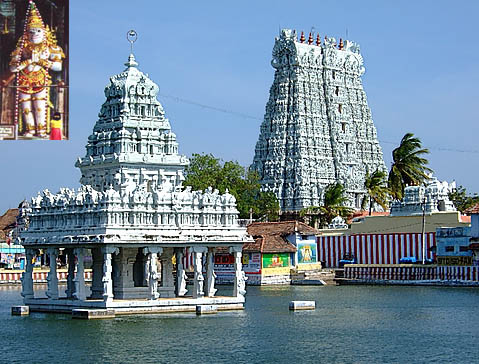Name of the Temple |
- Suchīndram Thānumālayan temple.
|
Location |
- Enroute from Nāgarkoil to Kanyākumari, Tamilnadu.
|
| How to reach there? |
- By Air : The nearest airport is Thiruvananthapuram International Airport. The airport is located 83 km north-west to Suchīndram on the National Highway 66.
- By Train : Nāgārkovil railway station is the nearest. It is located 4 km north-west of Suchīndram.
- By Road: Suchīndram is connected by the National Highway 66 from Kanyākumari to Panvel.
|
Rulers/builders and Time Period |
|
Deity/Deities |
- The name Thānumālayan denotes the combination of the Trimūrthis. Sthānu is a synonym for Śhiva, Māl for Viṣhṇu and Ayan for Brahma. It is believed that the top, middle and base of the Linga in the temple represent Śhiva, Viṣhṇu and Brahma respectively.
|
Architecture Style |
- Carved exquisitely out of a single block of granite, the imposing figure of Ānjaneya, 18 feet height, is a product of marvellous sculptural skill.
- The gigantic image of Nandhi locally known as "Mākāḷai" made of chalk powder is considered one of the biggest bull statues in India.
|
Special Reference to Fine Arts |
- The Thānumālayan temple is a repository of art treasures and of sculptures. Musical pillars and the huge Hanūmān statue are proof of the artistic skill of the time.
- The Stone Pillars of the temples can make the basic rhythm of Carnātic Music and these musical pillars are very impressive.
- The temple here is noted for its exquisite workmanship in stone and some of the sculptures in the temple like Vigneśhwari, the female form of Vināyaka and the scene of Gīthopadheśha of Pārthasārathi in the form of Trinity are rare and cannot be found elsewhere.
|
Other Special Features |
- The specialty of the Suchīndram Thānumālaya temple is that, this is the temple where all the three prime Gods - the Thrimūrthi - (Lord Śhiva, Lord Viṣhṇu and Lord Brahma) are found in one shrine.
- Tradition goes that Indhra was purified at this place and hence the name, Suchīndram. Suchi means Purity. Thānumālaya Swamy Temple is unique and stands proudly for the unity of Śhaiva & Vaiṣhṇava sections of Hinduism.
|
Any Other/Remarks |
- In Suchīndram, Brahma is being worshipped in the form of Śhivalingam.
|
Special Reference to Performing Arts: |
- The Ānjaneya Kruthis are composed by Muthuswāmi Dīkṣhithar are listed down.
|
Bibliography |
|















